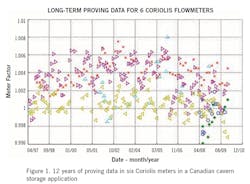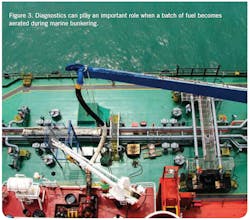Few would dispute the prominent role that flow meters play in plant operations today. Here, we’ll look at how new diagnostics technology and data are enabling Coriolis flow meters to not only address their own performance but also track broader process issues and deliver improvements across plant operations. Central to this is the emergence of new diagnostics and the concept of localized intelligence, through which measurement challenges can be addressed at a local level.
Coriolis flow measurement: An overview
Flow measurement is simply a quantification of the amount of fluid or gas passing through a channel medium, such as a pipe or a duct, with flow typically quantified by the flow meter as a volumetric flow rate (e.g., gal/min) or as a mass flow rate (e.g., lb/hr).
In the case of Coriolis flow meters, in the most common designs, the meter has two parallel flow tubes, and when the process fluid enters the sensor, it is split. During operation, a drive coil stimulates the tubes to oscillate in opposition at the natural resonant frequency. As the tubes oscillate, the voltage generated from each pickoff creates a sine wave – indicating the motion of one tube relative to the other. The time delay between the two sine waves is called delta-T, which is directly proportional to the mass flow rate: the greater the delta-T by the Coriolis force, the greater the mass flow rate.
Coriolis devices can also measure density, because the period of oscillation of the flow tubes, at its resonant frequency, is related to the density of the fluid in the flow tubes. The mass and density measurements enable the calculation of the volume flow, with all measurements tending to be highly stable over time. Meter performance is also enhanced, because there are no mechanical moving parts that will wear or fail, and no straight pipe runs are required for flow conditioning. Figure 1 shows 12 years of proving data from six Coriolis meters in a cavern storage application in Canada. What becomes immediately clear is that meter factors are very stable.
Today, Coriolis flow meters not only generate mass, density, and volume flow measurements, but also they often are the first instruments to detect wider process issues across the plant.
The costs of downtime
In the past, the ongoing maintenance and performance improvements of flow meters – whether to address moisture-causing electrical issues, corrosion, or unexpected changes in concentrations or temperature – tended to take place by removing the meters from the process loop and transporting them to laboratories for maintenance, verification, and/or calibration.
This has led to considerable costs and downtime and a negative impact on plant operations.
According to industry analyst ARC Advisory Group, the annual impact of unplanned downtime in the process industries alone is $20 billion (U.S.), or almost 5% of annual production, and 2%–5% of all lost production in petrochemical plants is attributable to unplanned downtime.
Closely linked to the interruptions brought about by the pulling of flow meters is the complexity of plants and how such meters interact with thousands of control loops – all necessary to adjust the values of specific variables, such as pressure, flow, temperature, conductivity and viscosity, to name some examples. This only exacerbates the impact of pulling meters from ongoing plant operations.
Smart Meter Verification
New diagnostic tools, however, are not only enabling meters to be verified and calibrated in-situ while in operation, but also they’re enabling such meters to address many of their measurement challenges at the local level. Built-in algorithms that detect and alert users to coating, corrosion, and erosion facilitate timely remedial action.
Moreover, because trending and contextualization of this data supports identification of precise actions to be taken while meters are still running, process control loops can stay in place.
One example of the value of these new tools is in the detection of coating. The ability to detect coating can provide insight into not only the meter’s health but also the wider process across the plant.
If the flow meter and diagnostics detect coating (which can have a negative impact on density measurements), the diagnostics can automatically trigger cleaning cycles without having to go through a distributed control system (as well as providing specific details as to when the buildup occurred).
The coating detection diagnostics can also alert the engineer when the CIP (clean-in-place) cycle is complete and there is no longer coating present in the meter. Furthermore, the ability to detect coating in the meter before a proving eliminates the need for return prover visits.
Sizing the meter and other verifications
Another example of the value of localized flow-meter intelligence at the process level is in the case of improper meter sizing – a particular challenge in fluctuating well conditions, where if a flow meter was originally sized for the oil well’s peak flow rate but the well begins to produce at a much lower rate, the plant operator and process engineer need to know immediately.
In such cases, flow-range diagnostics can verify whether the process flow rate is within the operating range of the flow meter and alert the user if that rate is below that used for sizing. This enables the operator to react to fluctuating production rates in real time with a resizing or repurposing of the meter then taking place accordingly. This is crucial to maintaining well mass flow measurement performance.
In addition, if the meter is operating at a high turndown and has experienced a temperature shift since the last time it was zeroed, the diagnostics will often recommend that the user perform zero verification.
If the meter is operating at a high turndown that is beyond the meter’s flow range specification, the diagnostics will often prompt the user to increase the flow rate through the meter.
Finally, if the meter experiences frequent or dramatic temperature shifts, a proactive alert that encourages running zero verification when appropriate can help the user maintain confidence in the measurement and process.
Figure 2 illustrates a typical diagnostics interface that includes actionable information on alerts and a historical alert record for troubleshooting issues that may have recently happened, as well as the previous 20 meter verification results, and alerts and remedies for potential process effects on meter performance. In this way, flow meters and their diagnostics are part of a wider information infrastructure that reacts to process upsets, leading to improved efficiencies and profitability.
While the industrial internet of things (IIoT) is already promising huge future potential for plant operators (industry analysis by International Data Corp. predicts that the IIoT market will grow to a staggering $1.7 trillion by 2020), it’s more important than ever for localized intelligence in process plants to come to the fore. In such cases, verification, calibration, and connectivity can take place intelligently and at a local level without the creation of unnecessary loops and as part of the growing role of Coriolis flow meters.
Looking beyond the meter
What we are witnessing is how localized intelligence and proactive diagnostics are enabling operators to look beyond the meter to see how other process variables, such as changing multiphase flow, can affect measurement performance.
Such diagnostics can also monitor live conditions to diagnose process upsets. Take the issue of aeration: The measurement of flow in a liquid can become considerably more challenging when there is aeration, leading to gas voids, line blockages and flow tube damping, which can have a major impact on Coriolis meters by reducing tube oscillation. The effect on the transmitters can also be damaging as they struggle to react to sensor signal changes.
Furthermore, when a batch of fuel becomes aerated during marine bunkering, for example – because valves aren’t closed, pumps aren’t properly started, or there’s excessive tank stripping – there can be a significant effect on meter accuracy, not to mention resulting bad batches and potential lost revenues. There is also a danger in batching applications where aeration can affect the custody transfer process.
In such cases, instead of waiting for other equipment to detect aeration, smart flow meters can do it themselves through multiphase diagnostics that immediately calculate aeration and its severity, instigate remedial action, and ensure the meters’ continued accuracy.
Smart intelligence across the plant
Whereas traditional diagnostics often provide just an entry point into further analysis, the latest diagnostics are ensuring an ever-more-important role for Coriolis flow meters – both in empowering them to address direct measurement challenges within the meter and addressing process issues across the plant.
It is this focus on smart, real-time, and often localized intelligence that is accelerating IIoT strategies and delivering improved knowledge, operational certainty, and productivity.
Tom O’Banion currently serves as the director of global chemical application innovation for Emerson Automation Solutions, Micro Motion Inc. He holds two patents and has 30 years of industrial application experience in a variety of roles, including greenhouse gas compliance, process and natural gas market development, and technical sales management. He received a bachelor’s degree in chemical engineering from the University of Colorado and an MBA in energy management from the University of Denver.



